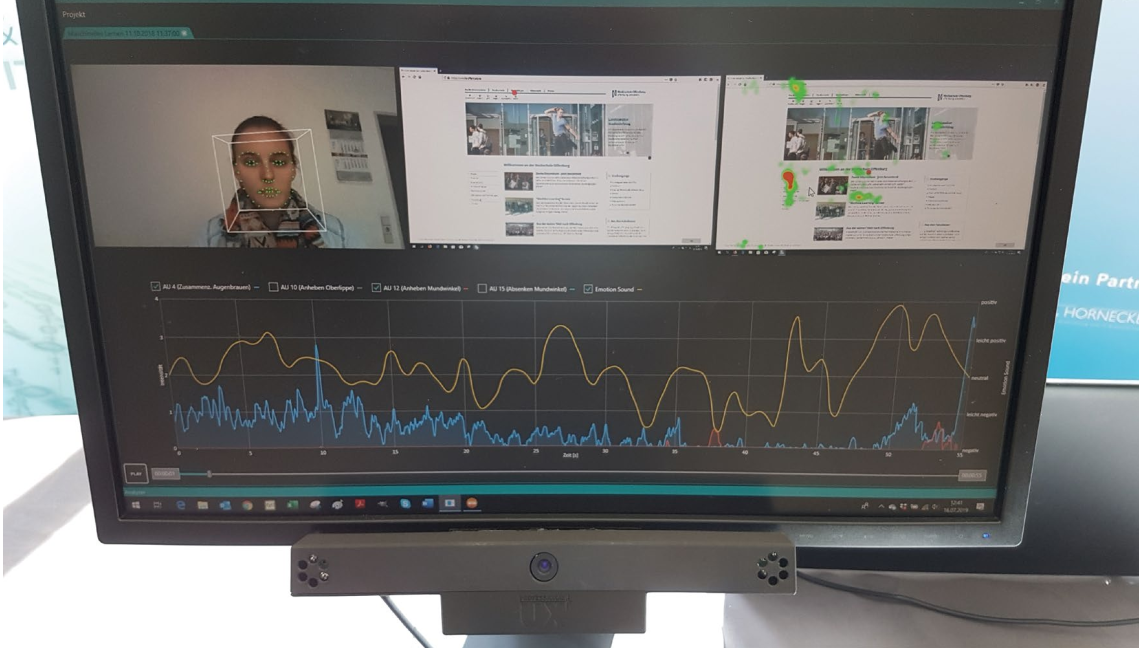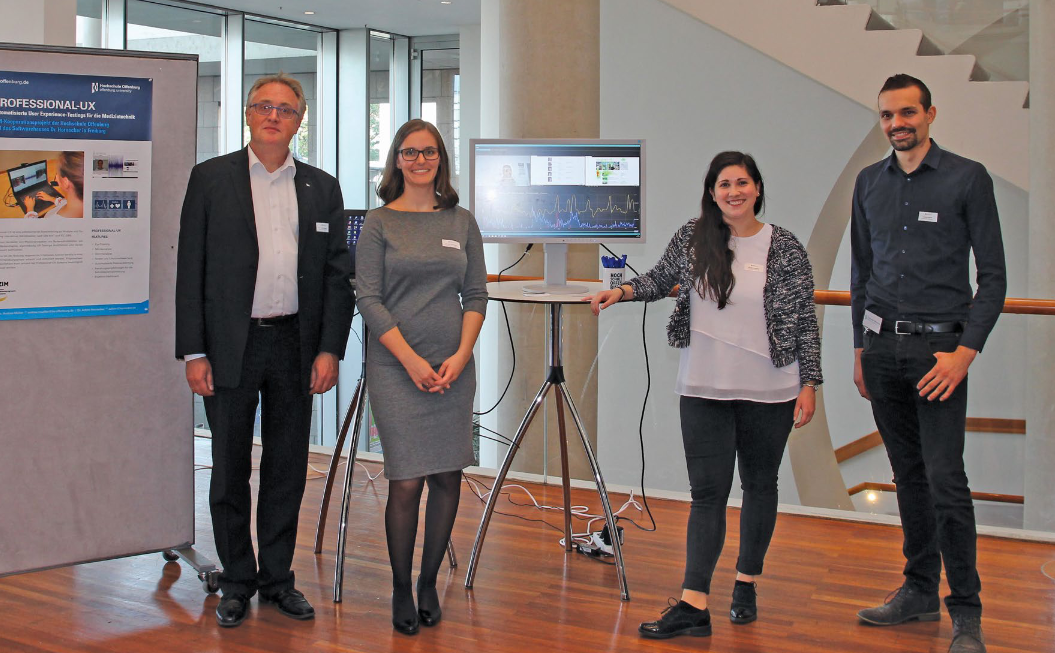Overall, the following passage underscores the value of Professional-UX in improving user interfaces, minimizing errors, and optimizing the user experience across different industries and platforms.
First Hardware and Software Prototype

Professional-UX Prototype
Evaluating User Experience through EyeTracking Data Analysis
Software for Extracting Key Parameters from Eye-Tracking
Eye-tracking data serves dual roles in this project.
-
Firstly, gaze tracking establishes the user-interface connection.
-
Secondly, these measurements form the basis for extracting parameters to gauge User Experience.
Initial steps involve identifying fixation (steady gaze) and saccade (rapid eye movement) time frames from eye-tracking data. Fixation duration and saccade length offer insights into interface usability, commonly evaluated using standard eye-tracking software.
Subsequently, specialized measures were developed to quantify user confusion while interacting with interfaces. Fixation data is clustered to create a directed gaze path graph, enabling calculation of metrics like gaze return frequency and cluster transitions. These metrics indicate confusion levels, using discrete algebra methods for computation.
Software for Extracting Key Parameters from Facial Expressions
In this project, facial expression analysis was optimized by reducing necessary measurement points. A modified version of the Facial Action Coding System (FACS) was tailored to focus on essential emotional parameters relevant to User Experience (UX).
Targeting negative emotions such as frustration and confusion prevalent in UX testing, this approach allowed precise training of machine learning techniques. Even from test data collected during extensive lab measurements, specific algorithms were developed to classify UX-relevant parameters effectively.
Software for Extracting Key Parameters from Voice
Similar to facial expressions, we defined and extracted relevant features from audio signals to identify UX-related voice parameters. Successful machine learning training was applied to these extracted features.
Prototype functionality was proven through a university dataset. However, more training data is needed for a market-ready product. Using public emotion and voice data was counterproductive due to actor-based exaggeration.
Gathering additional data is crucial for robustness across various conditions before final market launch.
Measurement Analysis Software Interface
For developing analysis methods and showcasing various presentations, a prototype analysis interface was created. Key parameters were visualized as time-based curve plots. This visualization feature generated significant interest during field testing, providing substantial feedback for finalizing the prototype.
Applied Machine Learning Methods
In the research project, we investigated and implemented Geometric Deep Learning approaches. While these methods were more computationally intensive, they did not provide significantly better results.
Thus, we separated geometric pre-processing from Deep Learning and combined it with classical machine learning methods.
This combination yielded better performance compared to Deep Learning methods.
Results of Field Tests with the Innovative Device Professional-UX /Field Test Results with Professional-UX Device
Field tests were conducted at the Peter Osypka Institute, specialized in cardiology at Hochschule Offenburg. Six experienced medical engineering students who had completed the pacemaker programming lab participated. They used the Medtronic Viatron 2090 pacemaker programming device for testing.
Test participants successfully recognized the core functionalities of the innovative eye-tracking device, including attaching it to a tripod. The setup, use, and dismantling processes were found to be straightforward and efficient.
Scientific Presentations and Publications
Hochschule Offenburg’s team members, Prof. Dr. Andrea Müller and Christina Miclau, M.A., presented interim project findings at HCI International2019 in Orlando, Florida. This led to a co-authored publication titled ‘Avoiding Mistakes in Medical High-Tech Treatments and E-Commerce Applications – a Salutary UX-Research Innovation.’
Additionally, Christina Miclau presented these findings at the 14th Scientific Interdisciplinary Congress for Dialogue Marketing at Hochschule Pforzheim in September 2019. A collaborative contribution titled ‘Seeing and Hearing User Problems in E-Commerce: How AI Supports User Experience Analysis’ was published in the proceedings of the same congress.
The Professional-UX Project Team at the SME Congress

The project partners showcased interim results at the SME Congress, IHK Retail Symposium, and i+e Industrial Fair. The successful collaboration combined academic expertise and practical experience, fostering synergies. For marketing, BiSigma GmbH, a subsidiary of Dr. Hornecker Softwareentwicklung, was established. Dr. Achim Hornecker leads this effort.The outcome offers an innovative approach to User Experience research, leading to new products and enhancements. The plan is to introduce the product primarily in German-speaking European regions through BiSigma GmbH.
Due to successful collaboration, partners plan further work on the EmoCare ZIM project, extending the achievements of Professional-UX to robotics in care, significantly involving the Affective & Cognitive Institute (ACI) at Hochschule Offenburg.
For more on the projects, visit https://www.professional-ux.de/ and www.affective-lab.org.de .